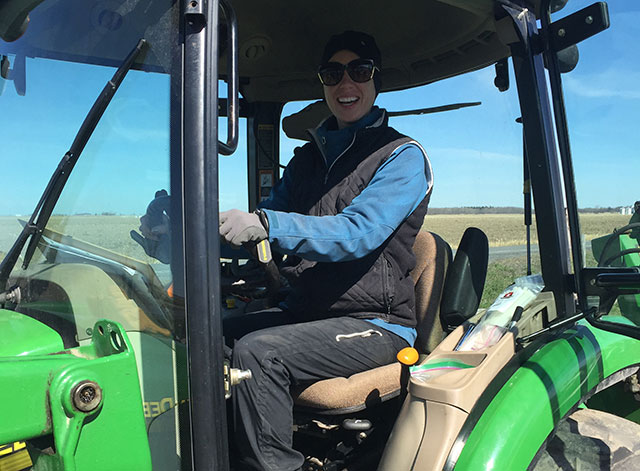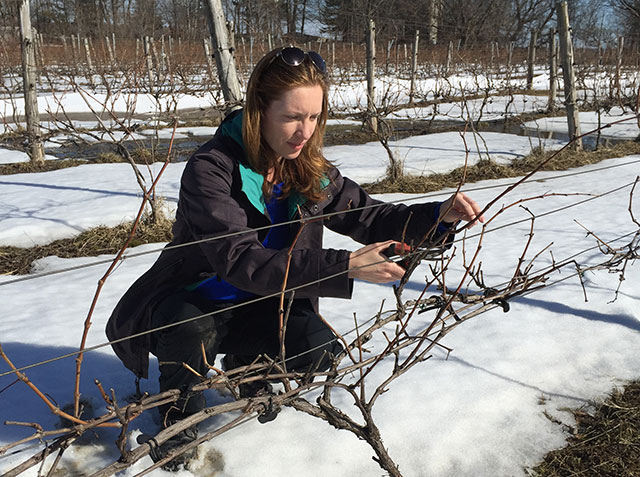Extreme viticulture for extreme climates
by Julie Peglau

Montreal, Canada: restaurants, culture, history, wine country. Wine country?
Yes, wine country. Across the St. Lawrence River lies the historic Montérégie region where wineries and cideries flourish. The region stretches north to Chambly, east to Roxton Falls and south of Montreal to the New York / Vermont border, about one and a half hours drive in any direction.
Wine has always been a passion. For ten years, I had the great fortune to sell wine in Edmonton to an amazing community of restaurants and wine stores. Since then, I completed an associate degree in Enology & Viticulture in Pennsylvania, specializing in cold climate conditions. The program was challenging, but I was lucky enough to intern with a great mentor, Larry Kennel, at the Vineyard at Grandview in Lancaster County.
Now, I am the assistant winemaker at Vignoble Le Mas des Patriotes, a boutique winery located 40 minutes south of Montreal. It’s hard to believe that I’m heading into my fifth vintage of wine production, my third at Le Mas. I’ve swapped my heels for steel-toed boots, learned to drive a tractor and I’m often covered in mud or wine. It’s a lot of fun.
But, I invite you to cast aside the romantic notions you may have about being a winemaker. While there are truly magical moments, it is without question the absolutely hardest job I’ve ever had, incredibly demanding both physically and mentally. Being a winemaker at a small winery means that you pitch in wherever needed. In the springtime, that means pruning the vineyard.
Pruning is an essential step in producing quality grapes. It’s not simply giving the plant a haircut. A grape vine is wild at heart and if left alone would grow out of control. As growers, we need to tame the vine, channel its energy and moderate the amount of fruit production so that not only will the grapes ripen properly, but also so the vine itself will be healthy enough to fend off pests, disease and winter injury. Pruning takes skill, patience and thoughtfulness.
For the grapevine, pruning is the wake-up call that spring is here and it’s time to go to work. This makes the timing of pruning tricky. The vine will start running sap and preparing its buds to burst. The bud contains all of the grape vine parts; shoots, leaves, tendrils and grapes all in microscopic size. Once awakened, the buds are extremely cold sensitive, so spring frosts are a major worry. If the late winter is milder than normal or if a grower prunes too early, the vineyard could be devastated by frost.
Wearing our parkas, we start pruning around April 1, when the worst of the cold is over and most of the snow has melted. By comparison, bud break has already happened in California two weeks earlier.
Pruning creates a farmable vineyard and sets up the growing area on the vine.
A vine is only capable of ripening so many clusters of grapes. This depends on several factors; vine age, health, variety, and climate. We must leave the correct amount of buds so that the plant can properly ripen the fruit, but not so many that the canopy is crowded.
Both local weather patterns and regional climate play a role in pruning decisions. In our humid summers, grapes need both sunlight and air movement to reduce moisture and prevent disease. Leaving too few buds will actually cause the vine to produce more leaves, creating shade and reducing airflow resulting in improper ripening and favourable disease conditions.

The way we approach pruning in a cold climate is far different from a warm climate like California. In fact, here in Quebec, we actually have two pruning seasons, spring and late fall. Our more cold-tender varieties, like Baco Noir, must be covered with tents or hay to withstand the low winter temperatures of -27 Celsius. This means that we have to prune them in November when they are entering dormancy, otherwise the vines wouldn’t fit inside the protective coverings. Vignerons around here call it extreme viticulture. Because of the harsh climatic conditions we face, like punishing winter temperatures and the looming threat of late spring frost, we also have to leave extra, or spare parts, on the vine.
The grape vine has a lot of natural back-up and self-protection systems, but it still needs help to survive and produce quality fruit. We have to make pruning decisions that are insurance policies for the vine. For example, we might grow a vine on two trunks instead of one, in case one dies.
There’s a lot to consider every time you make a cut on a vine. Not only are you setting up the growing area for this season, but for years to come. Rarely does a vine battered by our cold climate look exactly like a textbook diagram so you must understand the impact of your action or non-action. Sometimes, for the good of the plant you have to make extreme decisions and remove a trunk or saw off a cordon. Early in the pruning, we’re all a little nervous to make big choices. You’ll hear “grand décision?” called from another row. We’ll look at the vine and make a decision together. As the days pass, we grow more confident and there are fewer calls for help.
It’s incredibly rewarding to finish pruning a row. When the entire vineyard is completed it’s a major accomplishment. It’s now May and by the afternoon we’ve peeled down to T-shirts, decorating the vineyard with our coats and vests along the way. The vineyard is alive with energy; bud break will happen at any moment and the vines will begin their journey.
In Montreal, the terraces have spilled out into the streets and the tonic of warm sunlight enlivens the city. If I’m not too beat, I’ll dig out my heels and head to the Old Port to take in the sights and sounds of a city awakening to spring, enjoy a glass of rosé and the satisfaction of a hard day’s work.